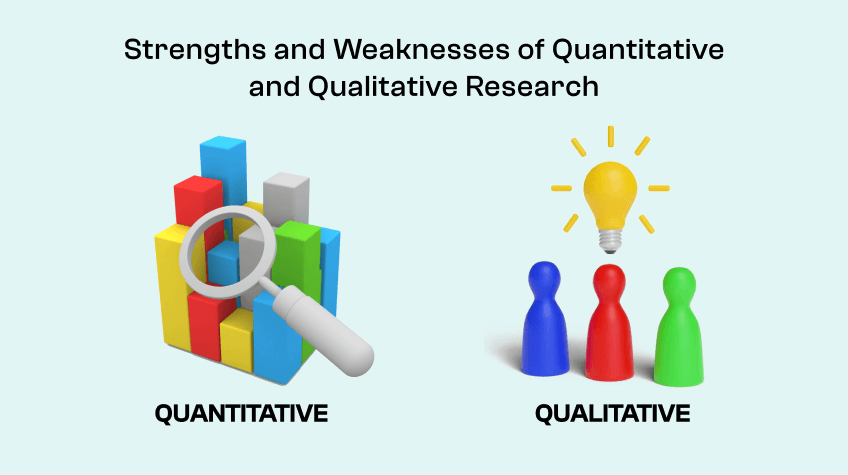
Research plays a crucial role when it comes to achieving success in the world of business. When it comes to good research, both quantitative and qualitative research matters the most in building marketing strategies. Data gained through quantitative research includes demographics, consumer growth, and market trends. All of these help businesses and marketers build new theories. Qualitative data, on the other hand, tests the existing strategies or theories based on the gathered data from open-ended sources. Organizations need both methods to run their business smoothly. Upon combining both quantitative and qualitative research, you can get more objective insights from data and achieve more impactful results.
Let’s discover more about the quantitative and qualitative research, including their strengths and weaknesses. But first let’s understand what these two types of researches are. Here we go…
What is Quantitative Research?
Quantitative research is a systematic investigation. It majorly focuses on quantifying relationships, behaviors, phenomena, or other variables by collecting and analyzing numerical data. This type of research is done to test hypotheses, measure outcomes, and determine patterns and trends. It provides theoretical analysis of statistical data, i.e. insights, calculations, and estimations. This research method significantly gathers quantifiable data to perform the systematic investigation. It employs statistical, computational, and mathematical techniques to provide accurate and reliable outcomes.
For this research study, the researcher often collects statistically authentic and valid information by conducting online surveys, questionnaires, and online polls. In addition, they use sampling methods. More often than not, this method is employed used in the fields of social sciences, economics, health, and marketing, among others to get unbiased results. It helps in drawing valid conclusions and making informed decisions to introduce transformative changes to society. Let’s now take a look at the strengths of this type of research.
Strengths of Quantitative Research
Now that you have understood what exactly quantitative research is, it’s time to look at the strengths of this research type. Here we go…
- Validity and Credibility: This type of research provide statistically valid and authentic results to help you make informed decisions.
- Objectivity and Unbiased: Data collection is structured. Therefore, researchers’ biases and preconceptions do not impact their findings.
- Broader Perspective: This allows for generalization and conclusions about a broader population. This makes the research findings more impactful and useful.
- Clear and Accurate Results: The theoretical analysis of statistical data is clear and accurate. This promotes its easy explanation to a wider audience.
- Forecast: This research study helps to forecast future trends. As a result of this, the researcher can make more informed decisions.
- Diversity: This research method allows researchers to collect quantifiable data from diverse sources such as online surveys, questionnaires, and more.
- Versatility: This is a versatile research method. It can be used in various organizations to benefit from data-driven decisions.
Let’s now take a look at the weaknesses of this type of research…
Weaknesses of Quantitative Data
Although quantitative research is versatile and its findings are very impactful, it has some weaknesses that you should know. Look at the following pointers to know the weaknesses of quantitative research:
- Alien to Real-Life Situations: Data collection is structural; however, it is often limited in nature. Since it is used to collect quantifiable data, often it is not related to real-life situations.
- Does Not Identify Causes: The objective of quantitative research is to find correlations between different variables. The researchers are concerned with how much and how many. However, they often avoid looking into the why part – why something happens.
- No New Idea: The quantitative research aims to test the hypothesis of existing concepts. It does not emphasize generating new ideas or discovering uncovered areas.
- No Subjectivity: It does not take into account human experience. There is no place for human opinions and feelings in this type of research.
- Time Consuming: It uses a larger sample size and complex data sets for analysis. Therefore, it is more time-consuming compared to the other research methods.
- Complex: The rigorous design of the study requires a high level of expertise to draw findings.
Common Types of Quantitative Research Methods
Go over the following types of quantitative research methods:
1. Surveys

Image Source – freepik/@upklyak
Researchers often conduct surveys to gather a huge data set that can be analyzed to identify patterns, relationships, and trends. For example, you can conduct online surveys to analyze customers’ experience with products or services. This analysis helps you identify customer satisfaction levels. Furthermore, you can discover areas of improvement or change.
2. Correlation Research
This is a non-experimental method. As the name says, this method is used to discover a correlation between two variables. It does not let extraneous variables intervene in the research study. If the correlation is positive, it indicates both variables are in the same direction. On the other hand, the negative correlation suggests both variables go in a negative direction. Furthermore, this type of research method only uses existing sources to analyze the dataset. Therefore, it is considered cost-effective.
3. Causal-Comparative Research

Image Source – freepik
The casual-comparative method identifies cause and effect variables. Under this research method, one variable is dependent and another one is independent. Some researchers claim it to be similar to an experimental research method. However, this is not a complete experimental method.
4. Experimental Research
Experimental research method or true experimentation administers scientific techniques to test the hypothesis of the study. It aims to measure how independent variables impact dependent variables. Moreover, it controls extraneous variables to ensure the validity of the research design.
5. Result Analysis

Take a look at the following two methods to do the result analysis on the quantitative research:
Descriptive Analysis
This computes or calculates your datasets using mean, median, and mode to summarize the statistical dataset.
Inferential Analysis
As the name suggests, this includes inferences about what the data means. To ensure its effectiveness, researchers employ the three most common methods, including cross-tabulation, factor analysis, and T-tests.
Let’s now take a look at the important pointers you need to keep in mind when constructing surveys.
Pointers to Keep in Mind While Constructing Surveys
Check out the following pointers to know how to administer a perfect survey for quantitative research:
- The questions should be short and simple
- You should avoid asking for misleading information
- Image should be clear and legible
- Grammar and spelling mistakes can make data quality poor. So, avoid them.
Why Is Quantitative Research Important to Marketing?
Take a look at the following details to know how quantitative research is important to marketing:
Real-Time Insights

Quantitative research helps researchers gather real-time statistical data on market trends, consumer choice patterns, and the organization’s performance. Based on that, researchers compute or calculate complex datasets to gain insights into various aspects. Finally, the research insights help organizations understand the impact of their strategies. They can use this information to reform their business plans.
Improve Marketing Strategies
By gaining real-time data analytics reports on online marketing strategies, they can boost their brand visibility. This helps them determine new strategies for driving organic traffic to the website.
Competitor Analysis
Numeric data analysis helps organizations track competitors’ performance. Based on the in-depth analysis, they can compare their marketing strategies and performance with competitors. This helps them understand what they can do to increase their brand awareness.
Objectivity
The qualitative research method provides leaders with objective data. They can easily communicate this data with their team members. Furthermore, this objective data helps team members understand in which direction they should proceed to yield better results.
It’s now time to move on to another very crucial research type, i.e., Qualitative Research and understand it in detail. Here we go…
What is Qualitative Research
Qualitative research is an exploratory method. It primarily focuses on understanding human behavior, customer’s experiences, and social phenomena. It involves detailed and in-depth analysis. Unlike quantitative research, which emphasizes numerical data and statistical analysis, qualitative research strives to discover the causes of any problem by examining non-numerical data. Its main emphasis is on why rather than what. Essentially, it is subjective in nature because it typically relies on human experiences.
It employs open-ended techniques, including interviews, observations, focus groups, content analysis, and more, to collect rich data. This approach allows researchers to gain a deeper understanding of the context, motivations, and perspectives of participants. This method allows participants to express their issues and opinions in their own words. Based on the data, the researcher analyzes their attitudes, interests, behaviors, and motivations. It is often employed in the fields of education, sociology, psychology, and anthropology. The study focuses on the intricate and subtle aspects of human experiences. It often employs smaller sample sizes to facilitate an in-depth analysis of a problem. By capturing rich, detailed data, qualitative research offers a comprehensive view of the subject matter, highlighting themes, patterns, and relationships that cannot be gathered using quantitative research methods.
Strengths of Qualitative Research
Here are some of the noteworthy strengths of qualitative research that you must be aware of. Take a look…
- Data Collection: The qualitative research method is not restricted to participants’ pre-defined questions. It focuses on open-ended methods to enable data collection. Interviews/observations help a researcher gain a complete understanding of respondents. All in all, this research method focuses on collecting rich and detailed data.
- Novel Theories: This method allows researchers to generate new ideas/theories that can be opposite to conventional social beliefs and norms.
- Express in Numeric: The qualitative research method allows researchers to convert research findings into numeric data for a better understanding.
- Can combine with Quantitative Method: The researcher can combine qualitative research with quantitative research to gain incredible insights into the matter.
- Flexibility: This type of research is more flexible in nature than any other form of research, and it provides room for adaptability.
- Contextual Understanding: The researcher gains a deeper understanding of the social and cultural contexts of participants, resulting in more impactful findings.
Weaknesses of Qualitative Research

- Misleading Information: The researcher must adhere to rigorous standards when collecting and analyzing data. If they fail to do so, resources and expertise of low quality can lead to misleading results.
- Can Not Be Generalized: It is challenging to draw broad conclusions and generalize the data to a larger population using this research design.
- Time-consuming: In contrast to other research methods, the qualitative research method is time-consuming because it involves collecting data through multiple interviews and observations.
- Less Valid: Because of the human experience intervention, the qualitative research findings are believed less valid and less authentic.
Common Types of Qualitative Research Methods
Here are some common types of qualitative research methods to know:
One-on-one Interview
One-on-one interviews have emerged as one of the most popular qualitative research methods. It involves face-to-face or online interviews of the participants. This research method aims to understand and analyze the opinions, ideas, and experiences of the interviewee.
Focus Groups
This research method involves the researcher organizing a small discussion or interview with a group of participants. All of the participants need to discuss a specific topic under this method. The objective of this study is to gain an understanding of the beliefs and considerations of the participants regarding a particular topic.
Discussion Boards
Online discussion boards have replaced traditional discussion boards. Under this research method, researchers provide students with a set of questions to make them participate in the debate. This is a highly efficient way to understand their perspectives, beliefs, and ideas in different situations.
Case-study
Case study is yet another kind of method used for qualitative research. This method is primarily employed to gain in-depth information about the subject. It is important to note that the subject can encompass a wide range of entities, including organizations, countries, events, or individuals. A lot of researchers view the case study method as highly explanatory.
Pictures and Videos

Pictures and videos are also used as qualitative research methods to understand human experience through image or video analysis. They enhance the richness of data by allowing participants to express themselves in a non-verbal way. Based on visual elements analysis, a researcher reveals insights into social, cultural, or psychological phenomena.
Record-Keeping or Logging
Under this research method, the researcher collects authentic and valid documents from various sources. Further, the information is used as data. The findings of this research method are considered valid and impactful.
Ethnographic Study
Under the ethnographic study, the researchers act as an active participant or observer to study participants in their natural settings. This allows them to understand their social context, culture, and behavior in a much better way.
Observation Method
The observation methods involve the researcher’s subjective interpretation to observe and analyze the attributes and characteristics of a phenomenon. The data collection relies heavily on the researcher’s keen senses of taste, smell, sight, and hearing. He conducts thorough data collection and carefully analyses the entire event.
Result Analysis
Here are the two methods that researchers often employ for the result analysis of the qualitative research:
Deductive Analysis
Deductive analysis is often used to test existing theories, ideas, or beliefs. In qualitative research, deductive analysis is the process of applying predetermined codes to the data. The codes are often generated from literature, theory, or propositions that the researcher has developed. Furthermore, this is a structured method because it applies already decided research design.
Inductive Analysis
Inductive analysis builds up new theories based on specific observations or patterns. The basis of these theories is what has been seen and how it has been seen. Furthermore, it is a flexible analysis that is open to new information.
Pointers to Keep in Mind While Constructing Surveys
Some people claim that surveys can only be used in quantitative research. But this is not true. You can conduct surveys in qualitative research as well to make informed decisions.
Check out the following pointers to learn what you should keep in mind while constructing surveys:
- Use appropriate language
- Avoid unnecessary capitalization in words or phrases
- Use the correct format of the questions
- Make sure that multiple-answer questions do not have conflicting answer choices.
Why Is Qualitative Research Important to Marketing?
Qualitative research is ideal for marketing because it helps organizations acquire trustworthy information regarding their consumers’ changing demands, preferences, or tastes. Go over the following pointers to understand why qualitative research is important in today’s marketing scenario. Take a look…
Build Strategies

In this era of cut-throat competition, knowing about your customers is crucial. This is because based on that information only you can make right marketing decisions. Qualitative research helps organizations understand customers’ preferences and needs. Information gathered using qualitative research methods help businesses build new strategies to enhance customer’s experience. Strategies that businesses design using research data help them attract their target customers and improve their bottom lines.
Rebrand Products and Services
Often, researchers find this method very helpful. The information gathered using qualitative research helps businesses rebrand their products and services. Based on the results of the research, they come to know what their products and services lack. Also, they can determine what they can do to improve their products and services to attract their target customers.
Prevents the Risk of Customer Churning
Customer churning happens when a customer stops using a company’s products or services. However, qualitative research findings help companies understand their customer’s experience with their products and know what consumers want from their products or services. This reduces the risk of customer churning to a great extent.
Get Feedback from Customers
This method helps organizations get feedback on their products or services from customers. The feedback analysis makes a lot of sense in accelerating the organization’s growth.
The Bottom Line
So, this is all about the strengths and weaknesses of quantitative and qualitative research methodologies. Both quantitative and qualitative research methods showcase unique strengths, making them ideal for collecting data for different sectors. However, both methods do exhibit some weaknesses as well. Quantitative research excels in providing precise, measurable, and generalizable data through statistical analysis, while qualitative research offers rich, detailed insights into participants’ experiences, emotions, and social interactions. Quantitative research is considered best for testing hypotheses and identifying patterns across large populations.
At the same time, qualitative research is considered ideal for gaining a deeper understanding of underlying motivations and meanings. Quantitative research methodologies have a structured approach; however, they often avoid the complexities of human behavior and context. Well, that’s not the case with qualitative research methods. You can choose to use any of the research methods to write my essay for me online based on the industry you are serving. However, you can even combine both approaches to enjoy the benefits of both methods.
Thanks for reading!
Stay tuned for more such insightful posts!







Thanks for your post.